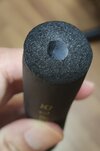See this article (warning: long read) to understand why transmitting heart or breath sounds over a live cellular call will not work.Our first intention is for doctor to hear live breathing sound from covid patients.
I was going to try and summarise it, but it is easier to simply quote the part salient to this discussion:
Sending a .wav or .acc file for playback on the doctor's phone bypasses these problems completely.Yet even if your cellphone distills crisp, noise-free speech, there’s no guarantee it will arrive at the listener intact. The next threat comes when the phone transmits the call to a base station. Modeled after standard wire-line phones, most mobile phones today digitize audio frequencies from 300 to 3,400 hertz. But unlike landlines, which provide each caller with a dedicated, full-capacity channel, cellphones must share a limited amount of wireless spectrum. So they compress the voice data to let more users connect.
Standard compression rates vary from 12.2 kb/s to 4.75 kb/s, depending on the volume of voice traffic and the strength of the wireless signal. Calls compressed to speeds as low as 7.95 kb/s can still sound almost as good as a landline connection. But beyond that, “you start to hear compression artifacts,” including missing syllables and distortions such as ringing or warbling, says Jerry Gibson, a wireless-engineering expert at the University of California, Santa Barbara.
If you’re making a local call to a mobile user on your own carrier network, count yourself lucky. The compressed data will likely travel to the receiving cellphone without further manipulation, and so voice quality may not be half bad. But say you’re talking to someone across the country or on a different carrier. In those cases, your local network will typically direct the call into the backbone telephone network, which was designed to carry landline traffic at 64 kb/s. So transcoding equipment at the exchange point must convert the mobile voice data to the higher wire-line rate.
A standard landline phone can decode that signal without losing more information. But if your call is sent to another cellphone, voice quality will take another nosedive when the base station serving the phone recompresses the data to fit into a cramped wireless channel.
 ? Anyway, not giving up yet and willing to continue and explore ideas proposed in this thread further.
? Anyway, not giving up yet and willing to continue and explore ideas proposed in this thread further.
